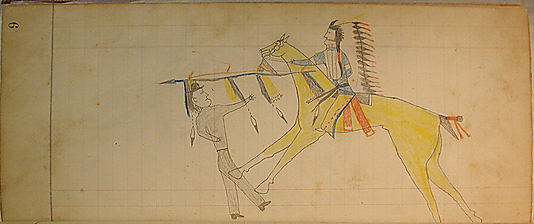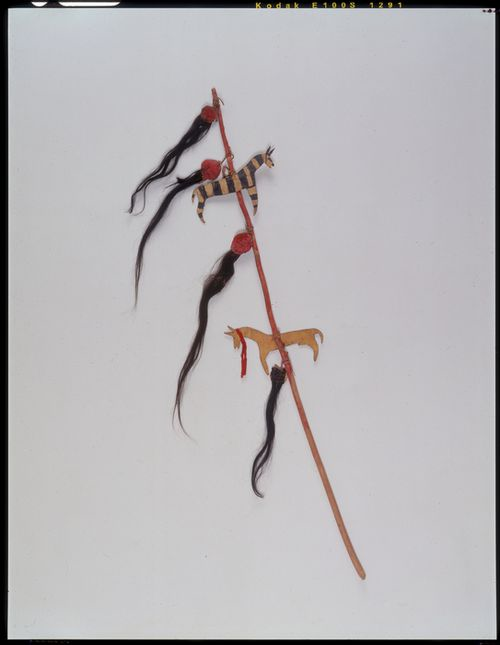Counting coup – I’ve known this phrase so long that I don’t ever remember not knowing it. It’s one of the cultural artifacts that somehow was handed down in my family. It wasn’t until I was an adult that I realized two things: First that everyone didn’t know what that meant and second, that it might be significant. In my family it was said as “counting coo” with the p being silent.
Counting coup was additive. Those little numbers never “went away.” Indeed, it was a very “Native” thing although I never realized it. It was just “normal” to us, a way of saying “Gotcha.” War without the blood. Made Mom happy.
But counting coup has a much deeper history beginning long ago and perhaps on both sides of the Atlantic. The Cheyenne or Arapaho pictograph below demonstrates the act of counting coup.
Counting coup refers to the winning of prestige in battle, rather than having to prove a win by injuring one’s opponent. Its earliest known reference (by act, not by that name) is from Shakespeare’s “Hamlet” (Act 5, Scene 2) where Laertes and Hamlet conduct a mock swordfight before King Claudius and Queen Gertrude. Hamlet strikes Laertes with his sword lightly, not enough to wound, and remarks, “Another hit; what say you?” To which Laertes responds, “A touch, a touch, I do confess.”
The point of counting coup was to avoid bloodshed during practice (or during the real battle). Otherwise, if a partner refused to be honest in acknowledging a strike, the practice could very quickly escalate into real bloodshed as the better opponent “proved” his point by actually sticking his sword into the naysayer. Thus, counting coup was considered the honorable thing to do for all concerned. Oh yes, and people kept track. If you killed your opponent, you only could add one notch to your belt, so to speak, but counting coup took more bravery and you could add several notches to your coup stick over time.
The photo above taken in 1910 by Edward Curtis shows a Piegan warrior wearing a war bonnet and holding a coup stick.
By other accounts the Plains Indians of North America also used a form of counting coup. Warriors won prestige by acts of bravery in the face of the enemy, and these acts could be recorded in various ways and retold as stories. Any blow struck against the enemy counted as a coup, but the most prestigious acts included touching an enemy warrior with the hand, bow, or with a coup stick then escaping unharmed. Touching the first enemy to die in battle or touching the enemy’s defensive works also counted as coup. Counting coup could also involve stealing an enemy’s weapons or horses tied up to his lodge in camp. Risk of injury or death was required to count coup.
A Piikuni (Blackfeet) coup stick from the 1800s is shown above.
Escaping unharmed while counting coup was considered a higher honor than being wounded in the attempt. A warrior who won coup was permitted to wear an eagle feather in his hair. If he had been wounded in the attempt, however, he was required to paint the feather red to indicate this.
After a battle or exploit, the people of a tribe would gather together to recount their acts of bravery and “count coup.” Coups were recorded by putting notches in a coup stick. Indians of the Pacific Northwest would tie an eagle feather to their coup stick for each coup counted, but many tribes did not follow this tradition.
In the photo above, taken in 1907, also by Curtis, High Hawk is dressed in a war bonnet and also holds a coup stick.





Pingback: The Battle of Dripping Springs | An Old Cop's Place
Very informative…thank you.
Thank you so much for this article. It is very helpful. I am using the counting coup reference in a paper I’m writing about the Cold War. It’s relevant and important to see how little we’ve changed.
What’s with the High Hawk photo? That’s no coup stick he’s holding, it’s a war club. Someone reaches out and “touches” you with one of those, you’re most likely going to be either dead or permanently disabled.
Thanks for the informative and reasoned post. I am interested in the topic because I find a certain ambiguity within contemporary understanding of American Indian cultural beliefs and practice..
Having grown up in the 19050’s I like many others am steeped in the “western mythologies ” of popular culture.
However your explanation is pretty much in line with what I have gleaned from growing up in Manitoba and Minnesota and having lived in Blackfoot country for more than 40 years.
I think that there is an unfortunate disconnect between the historical “white” record of early contact and contemporary understanding of the aboriginal condition.
I think we should be cautious about comments inferring that being “touched” by a coup stick would leave one seriously injured or dead. I believe that in reality the old ways were much more subtle and complex than one might think. Although it does look like a war club in the High Hawk photo.
And thanks for the classic reference to European history, I think you are quite right human nature doesn’t change; just the location.
This was very interesting – thank you. Re. Shakespeare & ‘Hamlet’ which you referenced; there is also the scene in ‘Romeo & Juliet’ where Mercutio is pierced w/ the sword & calls it just a scratch etc. Perhaps this dying speech of Mercutio where they think he is joking references that as well (?). xx
Thanks for describing this in detail. My mother used to describe this from time to time and I knew the basic idea, but not anything beyond that.
Since you mention European similarities to counting coup, I’d say the first example goes back even further. In the biblical book of Kings, David sneaks up on King Saul while sleeping and, instead of killing him, cuts a corner off of his tunic. Otherwise, very interesting article! I’ve been studying the history of the Lakota and found this practice and its relation to status very interesting!
When I served in Vietnam in 67-68 my units captain was part Indian. He kept a list of what he termed “his warriors”. To be on the list you had to:(1) have been wounded in combat by the enemy and come back to fight again; (2) have captured an enemy weapon in combat and used it as your own; (3) have touched the enemy in combat and done him no harm; (4) have lead men in combat.
He said it was part of his heritage. A number of us were on the list and were treated differently by him.